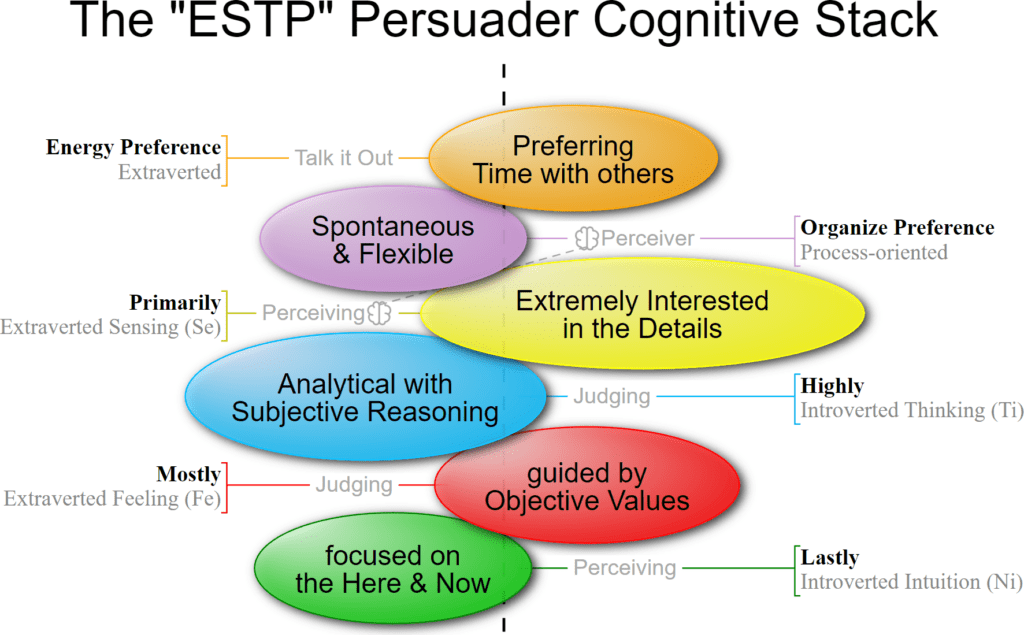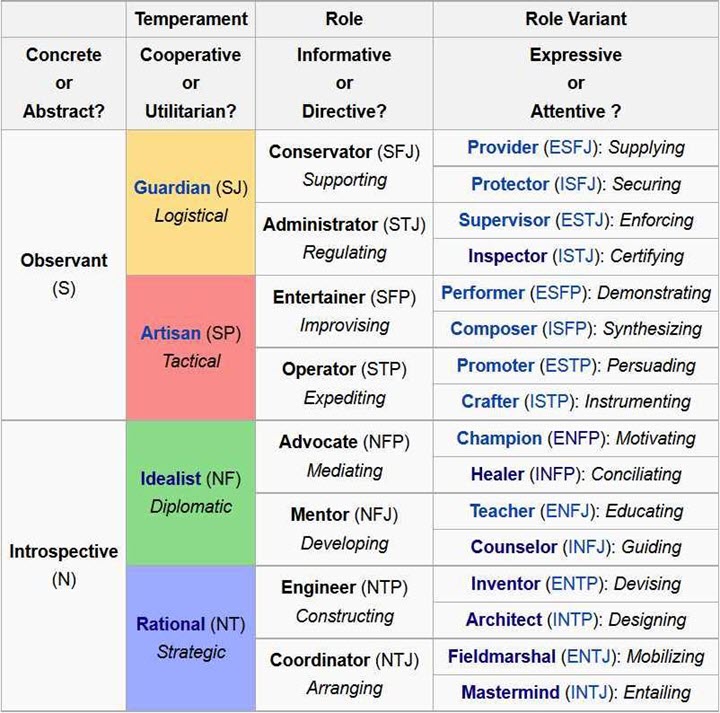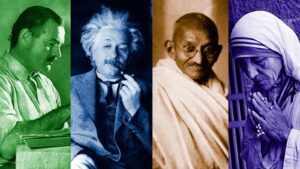What is the Keirsey ESTP “Promoter” Personality Type?
The Keirsey ESTP “Promoter” Personality Type is an Artisan Temperament with a Concrete Communication Style and a Utilitarian Action Style.
Keirsey organized the Four Temperaments as a matrix. There are two communication styles, abstract and Concrete, similar to the Myers-Briggs Intuition (Abstract) and Sensing (Concrete) “Perceiving” Cognitive Functions.
And by two action styles: cooperative and utilitarian. Utilitarian people, for the most part, do what works, while Cooperative people do what’s right.
Keirsey named the Four Temperaments as suggested by Plato: Artisan (Iconic), Guardian (Pistic), Idealist (Noetic), and Rational (Dianoetic).

Concrete versus Abstract Communication Style
Keirsey divided the Four Temperaments into two Communication Styles: Abstract and Concrete. These styles are similar to the Myers-Briggs Intuition and Sensing “Perceiving” Cognitive Functions.
Some people talk primarily about everyday reality’s external, concrete world: facts and figures, work and play, home and family, news, sports, and weather—all the who, what, when, where, and how of life.
Other people talk primarily about the internal, abstract world of ideas: theories and conjectures, dreams and philosophies, beliefs and fantasies—all the whys, ifs, and what might be of life.
In their daily lives, Concrete people talk about reality, while Abstract people talk about ideas.
According to Keirsey, everyone can engage in both observation and introspection. People are observant when they touch objects or otherwise perceive the world through their five senses. When people reflect and focus on their internal world, they are introspective. However, individuals cannot engage in observation and introspection at the same time. The extent to which people are more observant or reflective affects their behavior.
People who are generally observant are more ‘down to earth.’
They are more concrete in their worldview and focus on practical matters such as food, shelter, and immediate relationships. Carl Jung used the word sensation to describe people who prefer concrete perception.
Generally, reflective people have more ‘head in the clouds’ and more abstract worldviews. They focus on global or theoretical issues such as equality or engineering. Carl Jung used the word intuition to describe people who prefer abstract perception.
Cooperative versus Utilitarian Action Style
Some people act primarily practically or pragmatically; that is, they do what gets results, what achieves their objectives as effectively or efficiently as possible. They only check afterward to see if they observe the rules or go through the proper channels.
Other people act primarily cooperatively or socially acceptable; they try to do the right thing in keeping with agreed-upon social rules, conventions, and codes of conduct. Only later do they concern themselves with the effectiveness of their actions.
These two ways of acting can certainly overlap, but as they lead their lives, utilitarian people mostly do what works, while cooperative people do what’s right.
Keirsey compares the differing temperaments with cooperative (Complying) and pragmatic (Adaptive) temperaments. Cooperative people pay more attention to other people’s opinions and are more concerned with doing the right thing. Sensible people (Utilitarian) pay more attention to their thoughts or feelings and are more concerned with doing what works. No comparable idea in the MBTI or Jung corresponds to this dichotomy, a significant difference between Keirsey’s work and Myers and Jung’s.
The pragmatic temperaments are Rational (pragmatic and abstract) and artisan (Pragmatic and concrete). The Cooperative Temperaments are Idealists (Cooperative and Abstract) and Guardians (Cooperative and Concrete). Neither the MBTI nor Jung included the concept of Temperament in their work.
ESTP Keirsey/MBTI Correlation
| Keirsey | MBTI | |
|---|---|---|
| E | Expressive Role Variant | Extraverted Sensing |
| S | Concrete Communication Style | Dominate Extraverted Sensing Function |
| T | Directive Role | Auxiliary Introverted Thinking Function |
| P | Utilitarian Action Style | Sensing is a Perceiving Function |
With Extraverted Sensing as the first Dominant Function and Introverted Thinking as the second Auxiliary Function, the MBTI ESTP “Persuader” Personality Type sorts to the Keirsey ESTP “Promoter” Personality Type.

ESTP Personality Type cross-reference
- Keirsey Type – Promoter
- Temperament Type – Sanguine
- Animal Type – Golden Retriever
- DISC Type – Steadiness
- Socio-Communicative Type – Amiable
- True Colors – Orange
- Color Code – Yellow
- Personality Compass – South
- Occupational Type – Conventional
- Learning Type – Reflector
- Leadership Type – Accommodator
Enneagram Types
Promoter Personality Characteristics
There are many Promoters, maybe ten or so percent of the population, and life is never dull around them. In a word, they are men and women of action.
When a Promoter is present, the lights come on, the music plays, and the games begin.
Clever and full of fun, Promoters live with a theatrical flourish that makes even the most routine events seem exciting—not that they waste much time on regular occasions.
In work and play, Promoters demand new activities and new challenges.
Bold and daring at heart and ever optimistic that things will go their way, Promoters will take tremendous risks to get what they want and seem exhilarated by walking close to the edge of disaster. Because of this, they make the very best trouble-spot administrators and negotiators, and they can be outstanding entrepreneurs, able to swing deals and kick-start enterprises in a way no other type can.
Promoters also have a hearty appetite for the finer things of life: the best food, wine, expensive cars, and fashionable clothes.
They are highly sophisticated in social circles, knowing many people by name and knowing how to say the right thing to almost everyone they meet.
Charming, confident, and popular, Promoters delight their friends and investors with their endless supply of stories and jokes. At the same time, these smooth operators are usually something of a mystery to others.
While they live in the moment and lend excitement – and unpredictability – to all their relationships, they rarely let anyone get close to them.
Promoters have a low tolerance for authority and commitment.
Promoters understand the maxim, “He who travels fastest travels alone,” well.
However, they are not likely to be lonely for long since their boldness and sense of adventure make them highly attractive to many other people.
Famous Promoters
Franklin Delano Roosevelt, Ernest Hemingway, John F. Kennedy, Donald Trump, Madonna, George C. Patton, Evita Peron, Winston Churchill, Grace Slick, and Teddy Roosevelt are examples of the Promoter Artisan temperament.

What are the Keirsy Personality Temerpaments?

David Keirsey, born in 1921, was an American psychologist specializing in conflict management and family counseling. He began researching human behavior and Personality in the 1940s.
Keirsey blended the Myers-Briggs Personality Types with Ernst Kretschmer’s model of the Four Temperaments, developing the Keirsey Temperament Sorter, which was made famous by his book “Please Understand Me.”
Instead of using the term Personality, Keirsey used Temperament. He viewed it as a configuration of observable Personality Traits, communication habits, patterns of action, characteristic attitudes, values, and talents. To Keirsy, Temperament encompasses personal needs, individual contributions, workplace contributions, and societal roles.
Keirsey correlated the sixteen MBTI Personality Types into Four Temperaments. He divided each Temperament into two Roles: informative and Directive. He subdivided the roles into expressive (extraverted) and attentive (introverted) role Variables.
Informative versus Directive Roles
Keirsey distinguishes between people who generally communicate by informing others versus those who speak by directing others. This distinction subdivides each of the four Temperaments into eight Roles.
Expressive versus Attentive Role Variants
Individuals who act before observing are Expressive. In contrast, people who follow before working are Attentive.
Expressive and attentive variants further subdivide the eight roles into 16 types correlating to the 16 Myers-Briggs personality types.


